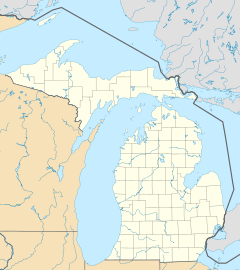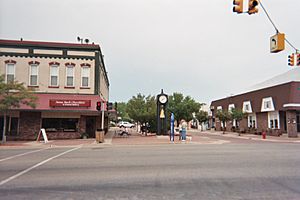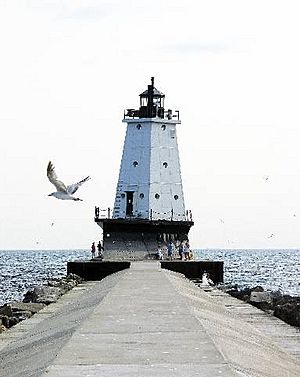Ludington, Michigan facts for kids
Quick facts for kids
Ludington, Michigan
|
|
|---|---|
| City of Ludington | |
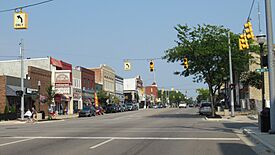
Downtown along E. Ludington Avenue (US 10)
|
|
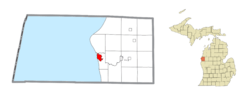
Location within Mason County
|
|
| Country | |
| State | |
| County | Mason |
| Settled | 1847 |
| Incorporated | 1873 |
| Named for | James Ludington |
| Government | |
| • Type | Council-Manager |
| Area | |
| • Total | 3.61 sq mi (9.34 km2) |
| • Land | 3.36 sq mi (8.70 km2) |
| • Water | 0.25 sq mi (0.63 km2) |
| Elevation | 591 ft (180 m) |
| Population
(2020)
|
|
| • Total | 7,655 |
| • Density | 2,278.27/sq mi (879.56/km2) |
| Time zone | UTC-5 (Eastern (EST)) |
| • Summer (DST) | UTC-4 (EDT) |
| ZIP code(s) |
49431
|
| Area code(s) | 231 |
| FIPS code | 26-49640 |
| GNIS feature ID | 0631201 |
Ludington (/ˈlʌdɪŋtən/ luh-DING-tən) is a city in the state of Michigan, in the United States. It is the main city and county seat of Mason County. In 2020, about 7,655 people lived there.
The city is located where the Pere Marquette River meets Lake Michigan. Nearby, you can find Ludington State Park, which has the Big Sable Point Light. There are also the Nordhouse Dunes Wilderness and Manistee National Forest. Ludington is also the home port for the SS Badger. This is a special ferry that carries cars and people across Lake Michigan to Manitowoc, Wisconsin every day in the summer.
Contents
History of Ludington
Early Settlers and Growth
In 1675, a French missionary and explorer named Father Jacques Marquette died near where Ludington is today. A memorial and a tall iron cross were built in 1955 to mark this important spot.
In 1845, Burr Caswell came to the area near the Pere Marquette River. He wanted to trap animals and fish. In July 1847, he brought his family, and they became the first permanent European settlers. They built a two-story wooden house. Later, this house became the first courthouse for Mason County. Today, it is part of White Pine Village, a museum with old buildings from Mason County.
The town was first called Pere Marquette. Later, it was named after James Ludington, a businessman whose logging companies helped the village grow. Ludington became a city in 1873. This was the same year that the county seat moved there. The city grew a lot in the late 1800s because of its sawmills and the discovery of salt underground.
By 1892, Ludington's sawmills had produced a huge amount of lumber. This made Ludington a very important shipping port on the Great Lakes.
The Car Ferries
In 1875, the Flint and Pere Marquette Railroad started shipping goods across Lake Michigan. They used a steamer called the SS John Sherman. Soon, they realized they needed bigger ships.
In 1897, the railroad built the first steel car ferry, the Pere Marquette. This was the start of a fleet of ferries that carried train cars across Lake Michigan to Manitowoc, Wisconsin. Later, these ferries also started carrying cars and passengers. By the mid-1950s, Ludington was the biggest car ferry port in the world!
Over time, fewer people used the ferries, and the fleet became smaller. Today, only one car ferry, the SS Badger, still makes regular trips across the lake from Ludington. It is one of only two car ferries left on Lake Michigan.
Geography and Climate
Where is Ludington?
Ludington is in western Mason County, Michigan. It sits on the east shore of Lake Michigan and the north shore of Pere Marquette Lake. It is about 58 miles (93 km) north of Muskegon.
The United States Census Bureau says Ludington covers about 3.61 square miles (9.34 square kilometers). Most of this is land, with a small part being water.
The Ludington North Breakwall Light stands at the end of the north pier on Lake Michigan. Ludington is part of the beautiful Northern Michigan area.
Weather in Ludington
Ludington has a humid continental climate. This means it has cold, snowy winters. Summers are warm but not too hot, thanks to Lake Michigan. The highest temperature ever recorded was 99°F (37°C).
| Climate data for Ludington | |||||||||||||
|---|---|---|---|---|---|---|---|---|---|---|---|---|---|
| Month | Jan | Feb | Mar | Apr | May | Jun | Jul | Aug | Sep | Oct | Nov | Dec | Year |
| Record high °F (°C) | 57 (14) |
63 (17) |
78 (26) |
85 (29) |
90 (32) |
97 (36) |
98 (37) |
99 (37) |
94 (34) |
84 (29) |
74 (23) |
65 (18) |
99 (37) |
| Mean daily maximum °F (°C) | 29 (−2) |
33 (1) |
42 (6) |
56 (13) |
66 (19) |
75 (24) |
80 (27) |
78 (26) |
70 (21) |
57 (14) |
45 (7) |
33 (1) |
55 (13) |
| Mean daily minimum °F (°C) | 18 (−8) |
19 (−7) |
25 (−4) |
35 (2) |
44 (7) |
54 (12) |
59 (15) |
58 (14) |
51 (11) |
41 (5) |
32 (0) |
23 (−5) |
38 (4) |
| Record low °F (°C) | −15 (−26) |
−22 (−30) |
−14 (−26) |
4 (−16) |
22 (−6) |
28 (−2) |
37 (3) |
36 (2) |
26 (−3) |
19 (−7) |
−8 (−22) |
−14 (−26) |
−22 (−30) |
| Average precipitation inches (mm) | 2.04 (52) |
1.68 (43) |
2.42 (61) |
3.30 (84) |
3.34 (85) |
3.52 (89) |
3.03 (77) |
3.55 (90) |
3.88 (99) |
3.63 (92) |
3.39 (86) |
2.48 (63) |
33.75 (857) |
| Source: Weather Channel, | |||||||||||||
Transportation in Ludington
All four main highways in Mason County pass through or near Ludington.
- US 10 comes into the city from the east. It connects Ludington with cities like Reed City and Bay City. It also continues across Lake Michigan on the SS Badger ferry to Manitowoc, Wisconsin.
- US 31 is a highway south of Ludington. It joins US 10 for about 5 miles (8 km) east of the city. Then, US 31 turns north again at Scottville.
- M-116 is a shorter road. It connects downtown Ludington to Ludington State Park in the north.
- Two U.S. Bicycle Routes, USBR 20 and USBR 35, also go through Ludington. USBR 20 ends at the SS Badger.
People of Ludington
| Historical population | |||
|---|---|---|---|
| Census | Pop. | %± | |
| 1880 | 4,190 | — | |
| 1890 | 7,517 | 79.4% | |
| 1900 | 7,166 | −4.7% | |
| 1910 | 9,132 | 27.4% | |
| 1920 | 8,810 | −3.5% | |
| 1930 | 8,898 | 1.0% | |
| 1940 | 8,701 | −2.2% | |
| 1950 | 9,506 | 9.3% | |
| 1960 | 9,421 | −0.9% | |
| 1970 | 9,021 | −4.2% | |
| 1980 | 8,937 | −0.9% | |
| 1990 | 8,507 | −4.8% | |
| 2000 | 8,357 | −1.8% | |
| 2010 | 8,076 | −3.4% | |
| 2020 | 7,655 | −5.2% | |
| U.S. Decennial Census 2012 Estimate |
|||
In 2010, there were 8,076 people living in Ludington. The city had 3,549 households. About 26.7% of these households had children under 18. Most people in Ludington were White (92.2%). About 6.3% of the population was Hispanic or Latino. The average age of people in the city was 43 years old.
Industries in Ludington
Ludington has several important industries. Just south of the city is the Ludington Pumped Storage Power Plant. This plant uses water to create electricity.
In town, there are companies like:
- Whitehall Industries: They work with aluminum, shaping it for different uses.
- Occidental Petroleum Corporation: This company makes calcium chloride products.
- Great Lakes Castings Corporation, Amptech, Inc., and Carrom Company.
- FloraCraft and Brill are also big factories in Ludington.
The Fitch Four Drive Tractor Company was also started in Ludington.
Media and Education
Local Media
Ludington has four radio stations and one newspaper.
- WKLA (1450 AM) plays talk radio.
- WKLA-FM plays adult contemporary music.
- WKZC-FM (licensed to nearby Scottville) plays country music.
- WMOM-FM (licensed to Pentwater) plays Top 40 hits.
The Ludington Daily News newspaper has been serving the area since the 1880s. Its website gets over 4,000 visitors every day.
Schools in Ludington
Students in Ludington go to schools run by the Ludington Area Schools district.
- Younger students attend Ludington Elementary School (PreK-5th grade).
- Middle school students go to O.J. DeJonge Middle School (6th-8th grade).
- Older students attend Ludington High School (9th-12th grade).
The sports teams at Ludington High School are called the "Orioles".
Notable People from Ludington
Many interesting people have connections to Ludington:
- Merrie Amsterburg – a musician.
- Antoine Ephrem Cartier and Warren Antoine Cartier – early settlers and developers of Ludington.
- Burr Caswell – an early settler of the Ludington area.
- Charles F. Conrad – founded the Lake Michigan Carferry Service.
- Mike Hankwitz – a college football coach.
- Henry L. Haskell – invented Haskelite and the carroms game.
- Ike Kelley – a former National Football League player.
- Père Jacques Marquette – a 17th-century French missionary who died near Ludington. A cross marks the spot where he passed away.
- William L. Mercereau – managed steamships for the Pere Marquette Railway.
- William Rath – a lumber businessman and former mayor.
Landmarks
- Warren A. and Catherine Cartier House – a historic mansion listed on the National Register of Historic Places.
Images for kids
-
SS Badger at Ludington
See also
 In Spanish: Ludington (Míchigan) para niños
In Spanish: Ludington (Míchigan) para niños


